The evolution of the internet and digital technologies means that you no longer need to be confined to a 9-to-5 office job. Some people, therefore, have come to see freelancing as the ideal way of working in these modern times, while others write it off as just another passing trend. If you’re wondering which of those is true, some cold and impartial freelance statistics are the way to go. They will give you objective information about this branch of the economy, regardless of whether you’re looking to hire a contractor at a lower cost or are considering a career change.
Freelance Statistics (Editor’s Choice)
- Over a third of freelancers are working from Europe. (Medium)
- Freelancers will account for 50.9% of the US workforce by 2027. (Website Planet)
- Freelance workers work an average of 44 hours per week. (Freelancer Map)
- One-third of first-year freelance writers earn up to $10 per hour. (Small Biz Trends)
- With 31+ million users, Freelancer.com is the largest digital labor-sharing platform. (Website Planet)
- 50% of the freelancers in the US are Gen Zers. (CNBC)
- 67% of freelancers typically complete up to 3 projects per year. (Freelancer Map)
General Freelancer Statistics
1. The US has the highest freelance earnings with YoY revenue growth of 78%.
A freelance industry report concludes that earnings from freelancing in America spiked massively from 10% in 2018 to an incredible 78% in 2019. This means that it is not only the number of freelancers in the US that has increased but their income too. The UK is ranked second with a more than satisfactory revenue growth of 59%, while Brazil follows with 48%. Other countries with booming revenue growth from freelancing are Pakistan, India, Ukraine, the Philippines, and Bangladesh.
(Payoneer)
2. Freelancing is a choice for 60% of people working independently.
These figures were obtained in a recent UpWork survey of more than 6,000 US workers over the age of 18. This number is estimated to be around 57 million Americans, says UpWork’s study. Freelancer statistics clearly show that working independently is something to be taken very seriously, especially since the remainder of folks in the freelancing business state have found their way into the industry as a result of being laid off or through other means.
(UpWork)
3. 35.5% of freelancers are working from Europe.
When we consider the number of freelancers in the world and their location, Europe might just be the cradle of freelancers with over one-third operating from there. Freelance statistics show that 29.2% of the global freelance community is concentrated in Latin America and 28% are in Asia. The remaining 10.1% of the freelance workforce is on the African continent.
(Medium)
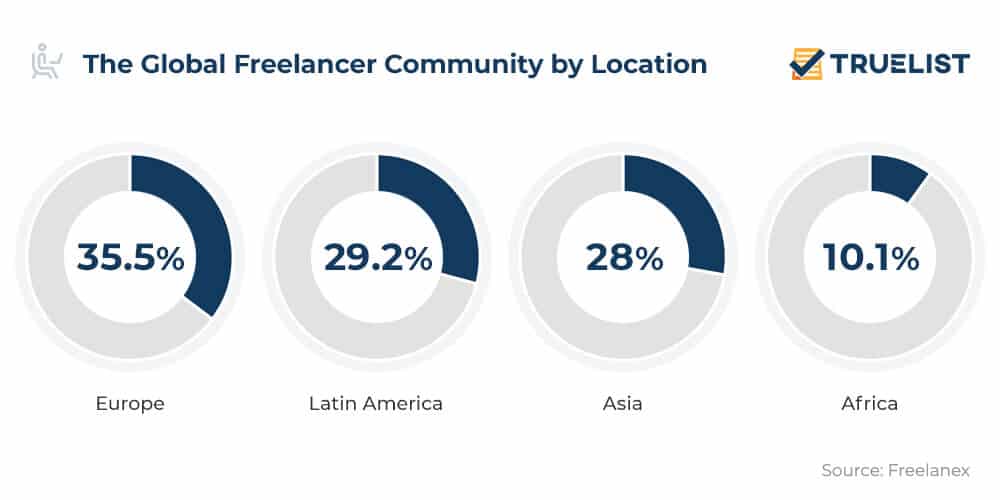
4. A relatively flexible workforce, including remote workers and freelancers, is the preferred choice for 59% of US companies.
The majority of companies in the United States nowadays rely on remote workers and freelancers to a certain extent. Data on freelancing in America and freelance workforce statistics show that the percentage of companies that opted for a flexible employment model amounted to 59%. Moreover, 61% of hiring managers say working with external talent is what keeps their full-time team up-to-date and informed.
(2020 Future Workforce Report)
5. Freelancers will account for 50.9% of the US workforce by 2027.
Freelancing is destined to continue growing in the future, despite how much it has already skyrocketed. Freelance statistics suggest that freelancers are estimated to rise to 50.9% of the US workforce by 2027, meaning that the traditional 9-to-5 jobs are slowly dying out. Also, projections are that if growth continues, over 67 million Americans will be freelancing by the end of 2021. What this means is that 42% of the US workforce will be on the freelance market.
(Website Planet)
6. Freelancers earn more than 70% of all professionals in the United States (on average, per hour).
Skilled freelancers earn $28 per hour on average, with “skilled” denoting services such as marketing, business consulting, and programming. Freelance economy statistics show that such services account for nearly half (45%) of all freelance work in the United States at the moment, compared to jobs like Lyft driving or dog walking.
(CNBC)
7. Freelance workers spend an average of 44 hours per week working.
Based on data from the latest freelance industry report, the majority of freelancers work between 31 and 50 hours per week. Freelance statistics further indicate a total of 37% of the freelance workforce spends between 41 and 50 hours a week at work. The second largest group or 32% works less than 40 hours, while around 6% of freelancers spend less than 30 hours per week working. In contrast, only about 5% work more than 60 hours per week.
(Freelancer Map)
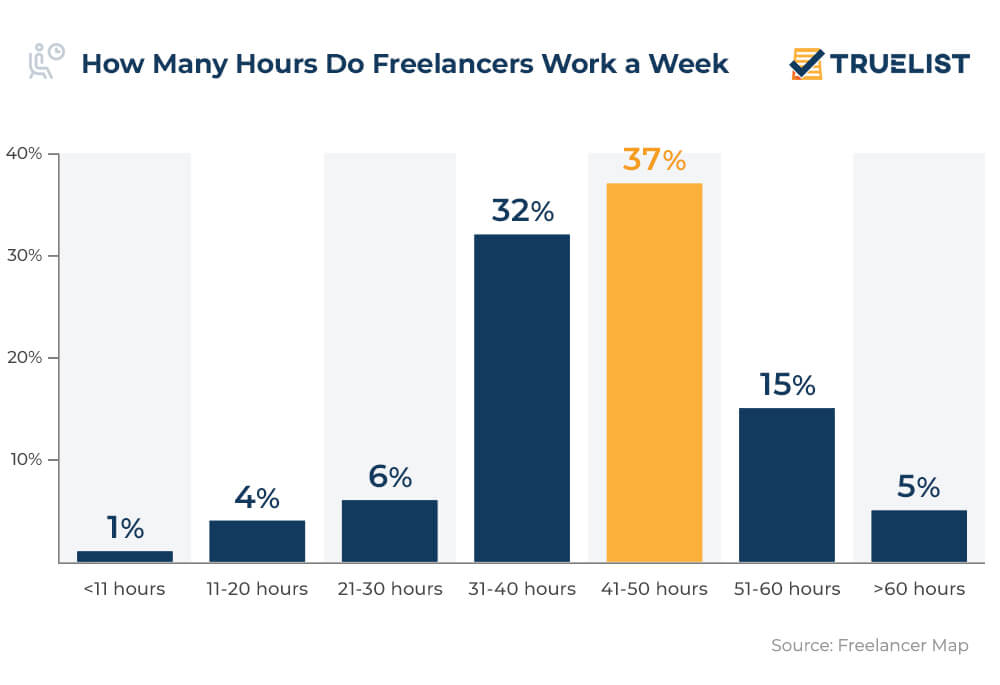
8. Male freelancers are more common in the US (59%) than their female counterparts (40%).
As one of the most freelancer-friendly countries in the world, the United States is the home to a remarkably large percentage of people who opt to work for themselves. Freelance workforce statistics reveal that the majority of those who embark on a freelancing adventure stateside are male (59%), with fewer females deciding to make the same choice (40%). Also, the majority or 62% of US freelancers are white, 16% are Hispanic, 12% are African or of African descent, and only 5% are Asian or Asian/American. All other ethnicities account for 4% of all US freelancers.
(Statista)
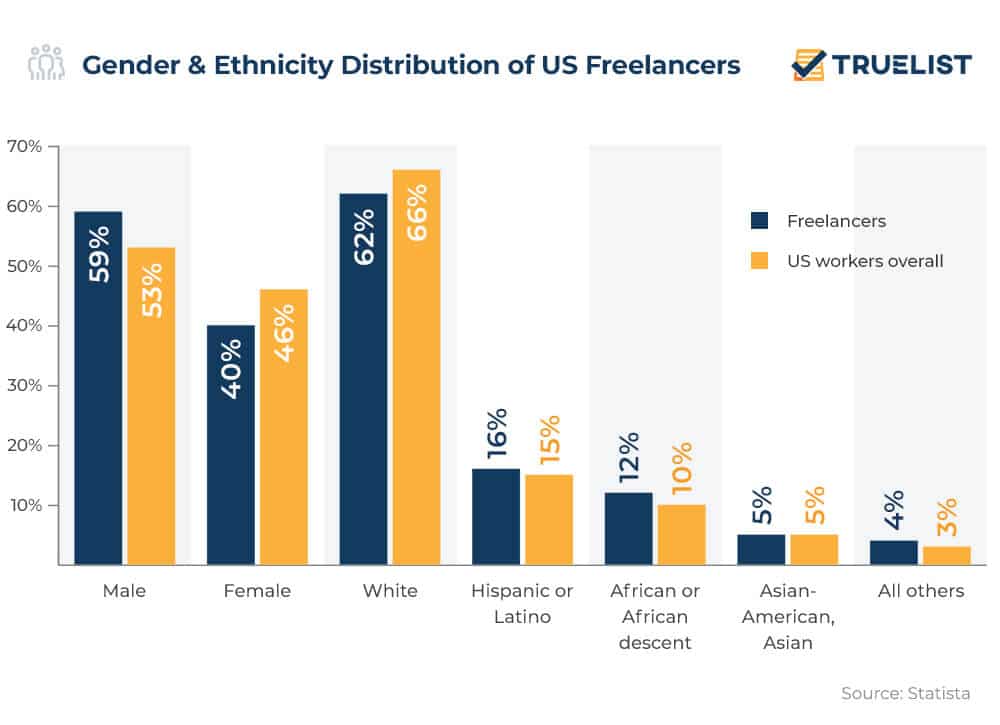
9. 68% of freelancers are not only much happier but also see a significant improvement in their lives.
One should, however, take this information with a grain of salt. Freelancing statistics confirm that while 68% of freelancers state their lives are much better and happier than before, 77% simultaneously say that ditching their full-time jobs to freelance has not made them more financially stable.
(Fiverr)
10. Almost half of the female freelancers make less than $25,000 a year.
Freelance economy statistics show that while only 34% of male freelancers fall into the lowest income bracket, a significant 48% of female freelancers are part of this group. This confirms that the gender gap is also present in the freelance market. Male freelancers are 4.5 times more likely to earn over $150,000 which is significantly higher than the income earned by women.
(Slash Workers)
11. Independent contracting or freelance work is a viable consideration for more than 90% of Americans.
Freelance statistics on jobs reveal that emerging economies are following the model of the United States, where a high percentage of people are open to the possibility of freelance work. To be more precise, more than 97% of workers in both Mexico and India wouldn’t say no to a temporary, contract, or freelance work, if given the opportunity. Overall, alternative working models are more highly sought after in countries where younger workers represent a significant part of the population.
(Manpower Group)
12. Freelancers see North America as their biggest client pool.
Freelancer statistics obtained in a recent study by Payoneer show that the majority of freelancers (36%) have clients across North America, with Europe taking second place with 27%. At the other end of the spectrum were Africa (4%), the Middle East (5%), and Australia (7%) as the regions with the fewest clients.
(Website Planet)
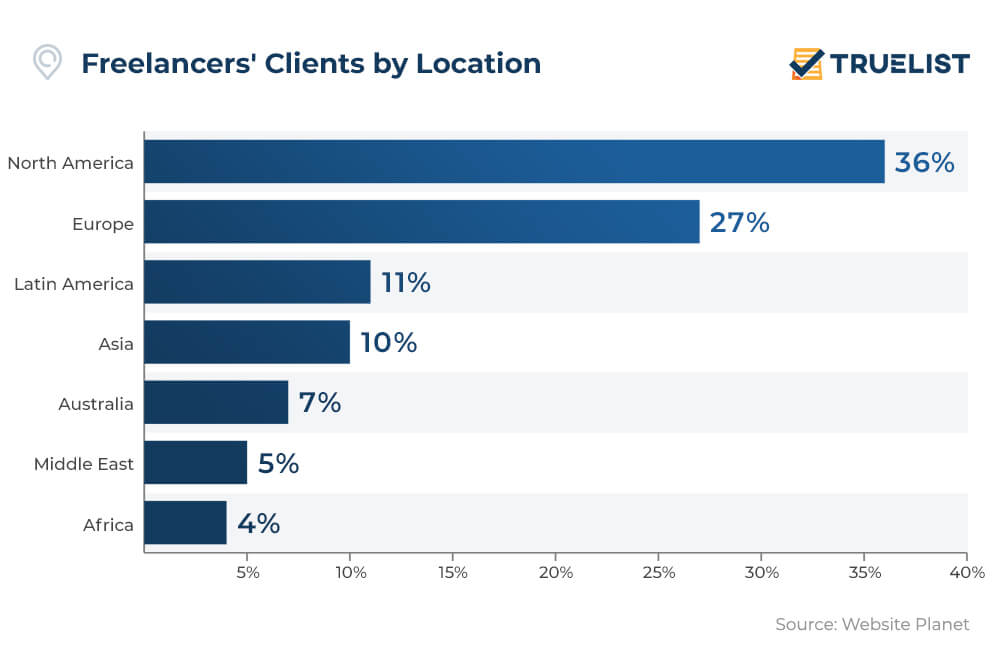
13. Freelancers are constantly working on improving their skill set, with 70% taking part in some kind of training.
Freelancer statistics indicate that a whopping 70% of self-employed workers have taken part in some sort of training over the past six months or so to improve their skills. This compares to just under half (49%) for their 9-to-5 counterparts.
(Website Planet)
14. One-third of first-year freelance writers earn up to $10 per hour.
30% of freelance writers make $10 per hour in their first year, and another 20% earn between $26 and $40 per hour according to the latest freelance writing statistics. Rates seem to get better after the first couple of years. Fact is, 60% of writers who earn an incredible $76 to $100 per hour have been freelancing for at least 6 years which proves that—as the case is with any profession—a freelance worker needs time to demonstrate their skills and develop.
(Small Biz Trends)
15. 50% of freelancers in the US are Gen Zers.
With 50%, according to Generation Z statistics, this age group dominates the American freelance market. Freelancer statistics further indicate that 44% are people aged 23-38, i.e. Millennials, while 30% are Gen Xers. What is interesting though is that although freelancing is a relatively new trend, Baby Boomers (55+) are also playing the game with 20% working on the free market.
(CNBC)
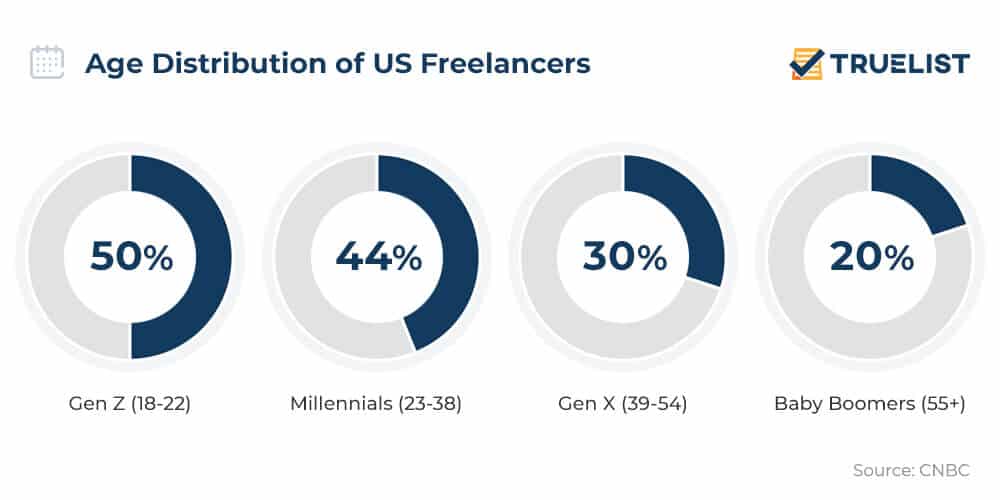
16. With over 31 million users, Freelancer.com is the largest digital labor-sharing platform.
In terms of online platforms that exist exclusively to assist people in finding freelance assignments tailored to their needs, freelancing statistics confirm that Freelancer.com is the preferred option for 31 million freelancers.
(Website Planet)
17. 67% of freelancers typically complete up to 3 projects per year.
While working on an average of 3 projects seems to be the strategy of choice for 67% of freelancers worldwide, freelancing statistics for the remainder of the spectrum are equally interesting. Delving into 10 or more projects per year is a feat only 8% of freelancers attempt. The percentage of freelancers that separate their time between 5 and 9 projects comes in at 12%, and approximately 21% of freelancers only opt to work on one project a year.
(Freelancer Map)
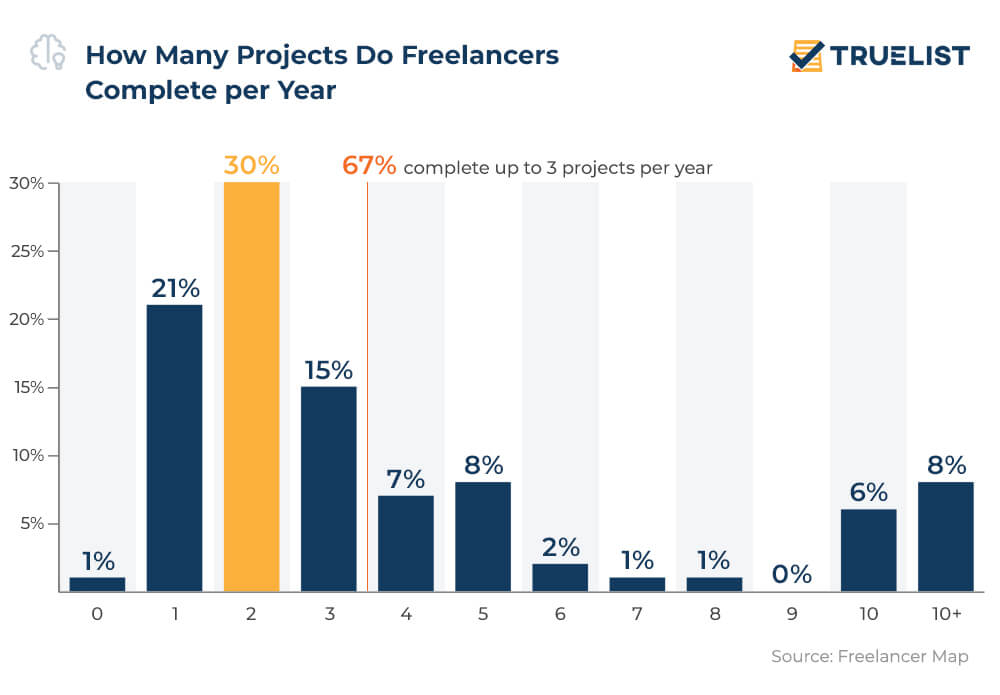
18. Living away from the big city is the preference of 7 out of 10 freelancers.
When it comes to the freelancing life, Upwork statistics reveal most freelancers would consider it a huge perk to be able to move anywhere, regardless of whether it’s a studio by the waterfront or a remote cabin in the woods. Apparently, 7 in 10 freelancers today desire the latter. And since not everybody is suited for city life, a freelancing job could be a wish come true for professionals who enjoy nature.
(Upwork)
19. 40% of US freelancers see healthcare as their biggest issue
US freelancing statistics also reveal that, compared to non-freelancers, freelance workers are more concerned about receiving health services. Furthermore, roughly 34% of freelancers admitted that their financial situation is getting worse, which explains the concerns.
(Entrepreneur)
20. A whopping 96% of freelancers believe the market has changed in the past 3 years.
The freelance market is constantly changing, and the majority of freelancers (96%) agree on this. Recent technological developments have had a positive impact on freelance workers and, as confirmed by UpWork statistics, 77% now find it easier to get a job because of it. Another 71% confirm that people’s general perception of freelancing as a career path is changing for the better. And since we are discussing positive changes in the freelance industry: 64% of workers say that professionals at the top of their industry are increasingly choosing to work independently.
(UpWork)
21. 71% of US workers are full-time freelancers because they want a flexible work schedule.
One of the many perks of freelance work is flexibility in the work schedule and according to freelance statistics, it is the main reason why 71% of full-time workers have switched to freelancing. At 66%, the second most common reason why people freelance is because they wish to be the bosses of their own time and resources, while 66% of full-time freelancers chose this career path because they wanted to work from a location of their choosing. Other common reasons why workers choose the freelancing life are because they want the freedom to choose their own projects, be in control of their financial future, earn extra money, and have independence from office dynamics.
(Statista)
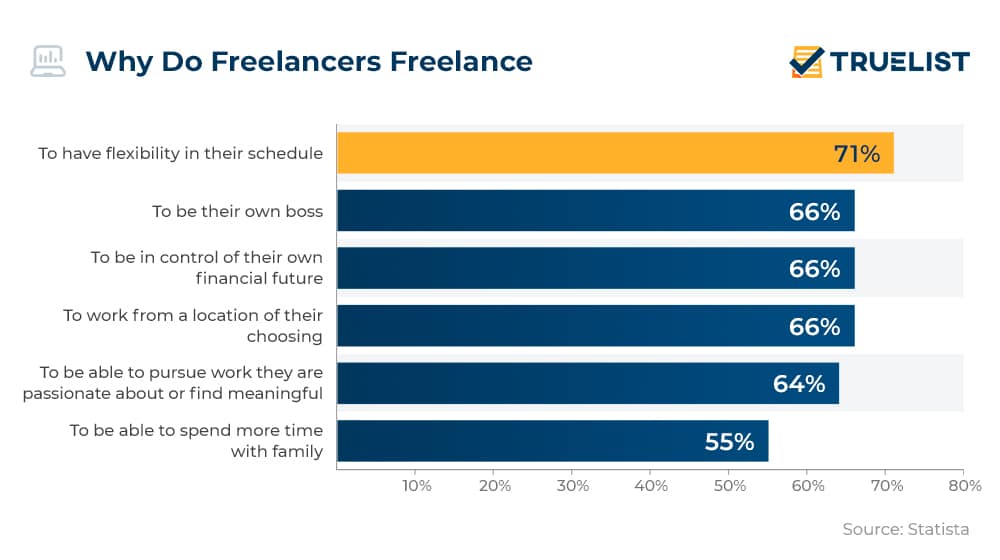
22. 40% of full-time freelancers are more educated than the average US worker.
Freelance workforce statistics show that in terms of education, 40% of full-time freelancers have earned themselves a four-year college degree making them more educated than the average American worker. Only 34% of the US workforce has obtained a four-year college degree. The same research shows that 17% of full-time freelancers hold advanced degrees compared to 12% of the US workforce that rely on this level of education.
(Fundera)
23. Referrals and word of mouth are how 91% of freelancers find jobs.
For the majority of freelancers, referrals are the best and most reliable way to get a job, but there are other ways too. Freelancer statistics indicate that 48% find work assignments via a website or their personal portfolio, while another 37% opt for pitching and outreach. Exclusive job boards for freelancers and newsletters are how 33% of freelancers find work, while 23% do so via organizations, clubs, and unions.
(Slash Workers)
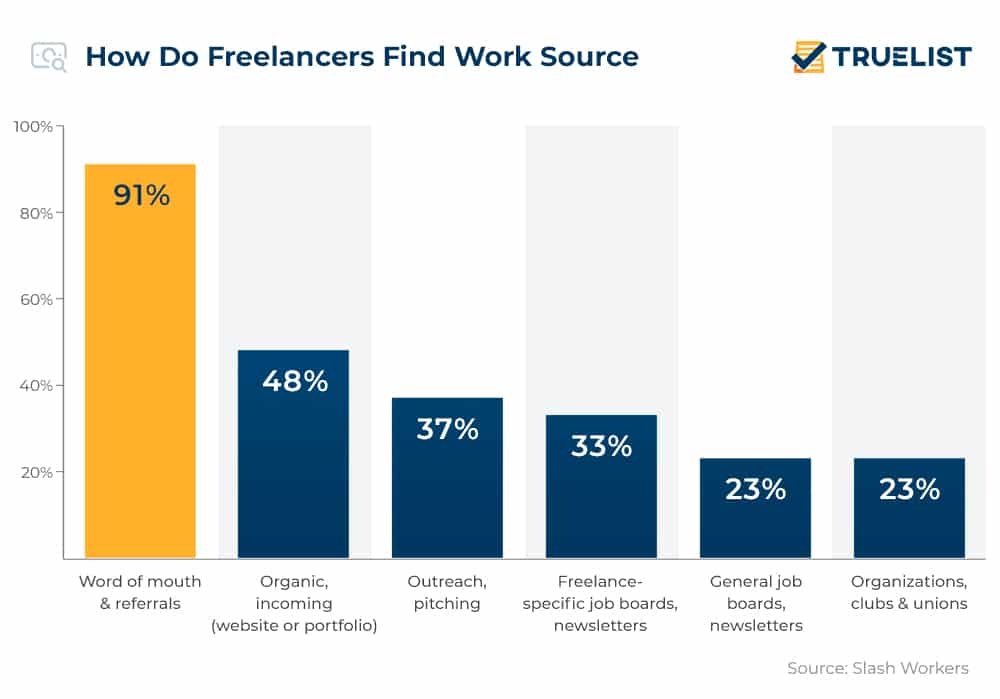
How Did COVID-19 Impact the Freelance Workforce?
24. Around 31.63% of freelancers believed the demand for freelance work greatly decreased during COVID-19.
There is not a single business that wasn’t affected by the sudden outbreak of the coronavirus pandemic. Naturally, the freelance market was not spared. Freelance statistics on jobs show some not-so-disappointing data with 22.85% of freelancers saying that the demand for freelance services since the outbreak remained the same, and 28.79% saying it only slightly decreased. A lucky 5.30% of freelancers saw a rise in demand, while another 11.43% said it slightly increased.
(Payoneer)
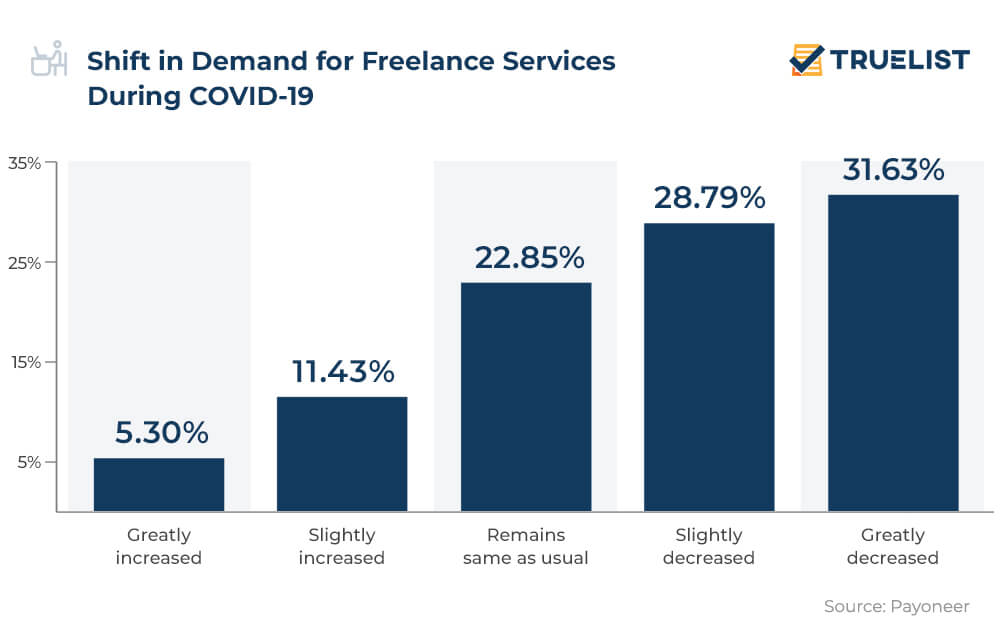
25. 73.48% of freelancers did not change their rates due to the pandemic.
Freelance statistics indicate that the majority of freelancers (73.48%) did not bother reducing or increasing their hourly rates. Although the only way to prevail during the outbreak of the COVID-19 pandemic was to adapt to the new situation, this did not really affect the hourly rates of freelancers. Only a minimal 3.45% of freelance workers increased their rates while 23.07% were obligated to slightly lower their hourly rates to remain competitive on the market.
(Payoneer)
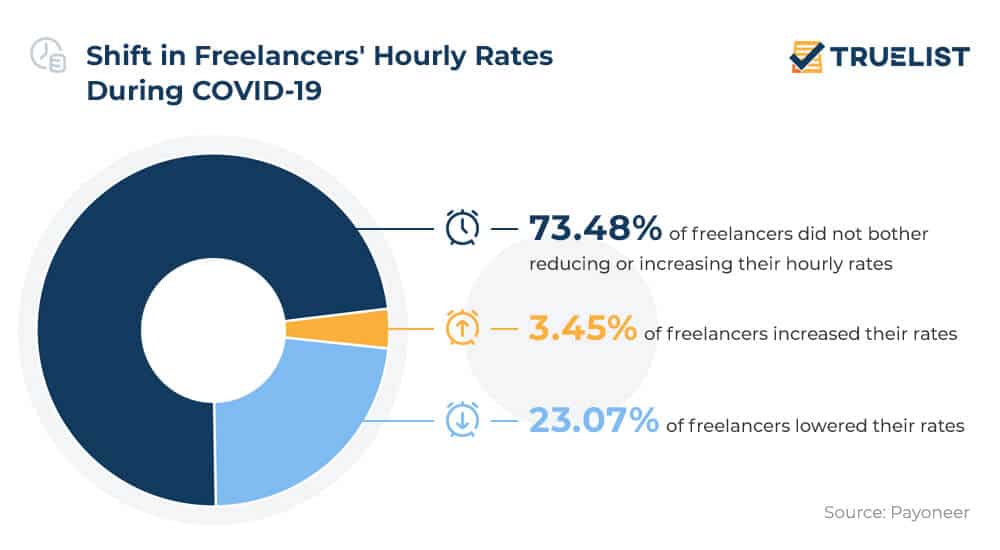
Frequently Asked Questions
How many freelancers are there in the US?
59 million of Americans freelanced in the past 12 months. Freelancing has become more popular among the most educated. The nature of freelancing to require more skill is clear in 51% of post-graduate workers doing freelancing, which is 6% more than in 2020.
(Forbes)
How big is the freelance industry?
The current size of the freelance industry exceeds $1.4 trillion, and this is only based on the American and Canadian markets that account for over 50% of the global distribution of freelancers. As one of the biggest markets globally for both clients and freelancers, the United States is a pioneer when it comes to this way of working.
(Flexiple)
How many Millennials are freelancers?
44% of Millennials did some freelance work according to a 2020 report from Statista.
(Statista)
How much can a freelancer earn?
Freelancer earnings vary across the globe and depend on the industry and skill level. Statistics show that those who do jobs that require a lot of skills at an average of $28 per hour. In general, a median pay for freelancers is $20.
(CNBC)
Final Remarks
Freelancing is not just about work, it’s a way of life that’s here to stay, with people around the world becoming increasingly infatuated with it. As these freelance statistics show, this type of working is well on its way to transforming into a highly sought-after career path while creating a pool of experienced professionals to benefit various industries, even in times of crisis.
Sources: Payoneer, UpWork, Medium, 2020 Future Workforce Report, Website Planet, CNBC, Freelancer Map, Statista, Statista, Fiverr, Slash Workers, Manpower Group, Small Biz Trends, CNBC, Upwork, Entrepreneur, UpWork, Statista, Fundera, Payoneer, Forbes, Flexiple, Statista

